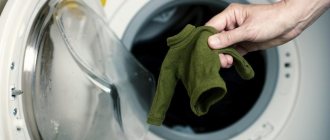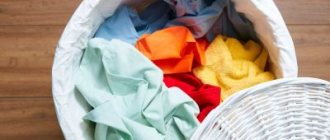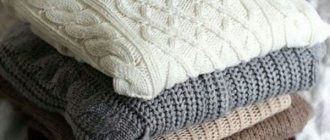The answer to the question of whether new clothes need to be washed is not obvious to everyone.
Some people avoid washing new clothes to make the item look presentable. And others, without fail, wash their clothes and linen out of disgust. In fact, new things are definitely worth washing, and the point here is not only that they have already been tried on before you.
CYCLE ONE - WHITENING
Initially, all natural fabrics (threads) are dirty brown.
They are soaked in bleach, hydrogen peroxide, acids or other bleaches to strip them of their natural color. Then it is dried and blown. What remains on the fabric? That's right, tiny dried particles of the solution in which it was bleached. And also the pigment residues that reacted with the bleach. If you put this freshly made item on yourself and you have sensitive skin, you may get irritated. From mild urticaria to severe contact dermatitis. Stop, you say. I don't wear white. I wear colored things! Fine.
How to wash new clothes for newborns correctly
Washing newly purchased clothes for newborn children is a mandatory process. It is not known who touched them and what path they traveled before getting to the counter.
Here are some tips on how to wash new clothes for newborns:
- You need to wash clothes for babies with a special powder for babies. You can also use fragrance-free baby soap. If this is not possible, you can use laundry (not white) soap. But after such a procedure, you need to rinse the item well to remove all alkali and odor.
- Do not use any conditioners. Even a product with the most harmless composition can provoke a severe cough in a baby.
- All washed items must be thoroughly ironed and steamed.
You can wash new clothes for babies either manually or in an automatic machine. Be sure to check the manufacturer's recommendations on the label; they may differ from those listed, depending on the material.
You can and should wash new things. Any item of clothing, be it a blouse or a set of underwear, goes through many stages of processing and transportation. If you wear such clothes without first washing, you run the risk of irritation.
There is no need to worry about fading of a new item after the first wash - follow all the rules and it will not lose its original appearance. In any case, it is better to be safe, especially when it comes to clothes for newborns.
CYCLE TWO - DYING THE FABRIC WITH A CONTINUOUS BACKGROUND OR APPLYING A PRINTED PATTERN
The procedure is the same.
Wet dye (aniline azo dyes) is applied to the fabric and then dried. Blow off what has dried on the surface of the fabric. But the more textured and thick the fabric, the more microparticles of dried paint remain on it. In their pure form, most aniline dyes are carcinogenic. Clothes may not be dyed because the grains of paint are baked and do not dissolve in water. But they end up on your body with your sweat. I generally only wear undyed and unbleached items! Fine.
Rules for washing new things after purchase - how to do it so as not to spoil the thing
Some people are afraid to wash things because after washing they can shrink, become faded and lose their original appearance.
To prevent this from happening, you need to wash your new clothes properly. The first and most important rule is to study the tag on the clothing, where the manufacturer indicates all the necessary information.
Recommendations will vary depending on the material:
- Wool, cashmere and silk cannot be machine washed - only by hand, only in cold water and only separately.
- Cotton can be washed either in an automatic machine or by hand, at a water temperature of 30-40 degrees.
- Synthetic materials can be machine washed. If the item does not contain elastic materials, you can safely use a machine spin.
In addition to the material, the color of the clothing plays a big role. The washing rules are the same for colored items, but different for black and white items.
Before washing new items, check the washing instructions on the label or tag.
How to wash black clothes
Often after the first wash, black items stop being black and become dark gray.
- To prevent this from happening, the temperature should not exceed 30 degrees.
- It is also important not to overdo it with washing powder. It should be slightly less than when washing colored laundry.
- It’s even better to use liquid gels for black clothes, since most washing powders contain bleaches, peroxides and chlorine.
How to wash colored clothes
Colored clothes of similar shades can be washed mixed. For example, a red sweater, a yellow dress and an orange turtleneck, or a green paita and blue pants can be washed together.
But, first, you should make sure that the thing will not be painted too much. To do this, dip a small part of the colored item in hot water for a minute, then run the wet part over the white material. If a pronounced tint remains on the white material, then it is better to wash the item separately and in cold water for the first time.
You can mix white things with colored ones only if the colored ones have a pastel tint. Otherwise, the white will either be completely colored or will have colored spots.
Washing bed linen
Many housewives have doubts when they are faced with the question of whether they need to wash new bed linen. However, there is no need to doubt it, since the linen is also impregnated with harmful chemicals. Moreover, the packaging could have been damaged during transportation, and if the material is natural, then no one can guarantee that the kit will be free from insects and ticks.
Here are some guidelines when washing a new bedding set:
- Wash bedding as a whole set, without mixing it with other items.
- It must be washed by hand at a temperature not exceeding 40 degrees.
- Instead of regular powder, use liquid gel, and then rinse your laundry in a special conditioner.
- When washing, it is not recommended to use bleaching powders, stain removers or color maintenance products.
- You cannot twist the laundry; you need to wring it out with your hands without much effort.
General recommendations
- The machine cannot be loaded end to end, but you should not leave a lot of free space. When the drum is completely clogged, the wash becomes much tougher, and as a result, the color of the items becomes more faded.
- Try to remove items from the machine immediately after washing. If you leave them in the drum for several hours, they may fade. We have already talked about how to get rid of faded stains on things, and how to avoid this in the future.
- Avoid machine drying. It is advisable to dry things in the open air, avoiding artificial heat sources.
- Use special powders and gels. It is important not to overdo it with their quantity. To get rid of stubborn dirt, use white vinegar. It also helps soften the material.
- To prevent new clothes from becoming faded after the first wash, turn them inside out. It is very important to follow this rule when washing bed linen.
- Before washing new bedding or any item of clothing, soak it in cold water and table salt for 10 minutes.
CYCLE THREE - PRE-SALES PREPARATION
To ensure that finished clothes, even the most natural ones, do not become moldy or wrinkled while they are being transported in containers from China to the store, they are processed. It is treated with water-repellent impregnations, the hypoallergenicity of which, believe me, no one cares about. And it is also treated with formaldehyde resin so that the fabric does not have strong irreparable creases. From the moment the thread first rolls off the spool onto the loom until the finished dress is in your hands, no one ever washes the fabric. They only apply various substances to it, which are not something healing for your skin. OH YES. LET'S NOT FORGET ABOUT THAT GIRL WITH ACNE WHO WAS TRYING ON A SKIRT RIGHT BEFORE YOU Therefore, no matter how much you want to show off a new thing right after purchasing it, wash it first.
Conventionally grown genetically modified cotton is 'the world's dirtiest crop'
You may be surprised, but cotton is considered the dirtiest crop in the world due to the heavy use of hazardous herbicides and insecticides in the cotton industry, including some of the most dangerous insecticides available on the market. According to the Organic Trade Association:
“Cotton is considered the dirtiest crop in the world due to the extensive use of insecticides and the most dangerous pesticides for human and animal health. Cotton covers 2.5% of the world's arable land, but uses 16% of the world's insecticides - more than any other single crop. Aldicarb, parathion and methamidophos , the three most hazardous insecticides to human health identified by the World Health Organization, are among the ten most commonly used in cotton production. Another six commonly used ones are classified as moderate to very dangerous. Aldicarb is the second best-selling insecticide for cotton and is the most poisonous to humans; just a drop of this substance can kill a person if absorbed through the skin; however, it continues to be used in 25 countries and in the United States, where 16 states have reported its presence in groundwater.”
As you can imagine, this is dangerous on several levels - for the farmers handling these chemicals, for the people living nearby, for the consumers buying the cotton, and for virtually everyone who will end up affected by this widespread environmental pollution.
This is the reason why I highly recommend choosing organic cotton clothing if possible - it will not be genetically modified and will not suffer from the terrible effects of toxins.
Garment factory - this item was sewn and ironed
After a long factory or manual process of forming a canvas from primary raw materials, the material ends up in the hands of a designer or factory. The fabric must be received and stored in a warehouse, prepared for production, patterns made using a stencil, cuts of the required size formed, sewn, and then ironed and packaged. How many hardworking hands were involved in this process? If they were cars, how clean were they?
Garment factory in China
What happens if you don't wash clothes from the store?
It is far from certain that wearing unwashed clothes will have bad consequences. But there is always a risk that:
- skin irritation (redness, itching and rash - from microparticles of chemicals and lumps of paint stuck between the threads);
- allergies (if a person has intolerance to any of the substances);
- skin and sexually transmitted diseases, less often - colds and flu (if the person trying on sweated or sneezed);
- increased risk of developing various chronic diseases.
Rather than risk your health, it is better to thoroughly wash the purchased clothes. One treatment according to the rules is enough to completely protect yourself from trouble.
Fabric production, transportation and sales
First, it was necessary to produce those materials that were involved in the manufacturing process of the final product. The main fabric and, possibly, the lining were made at the factory by hand or on special large machines. How clean was it? How many people were involved in the transportation? How were the fabrics treated before going on sale? And this is just the first step.
Textile store, Chicago











